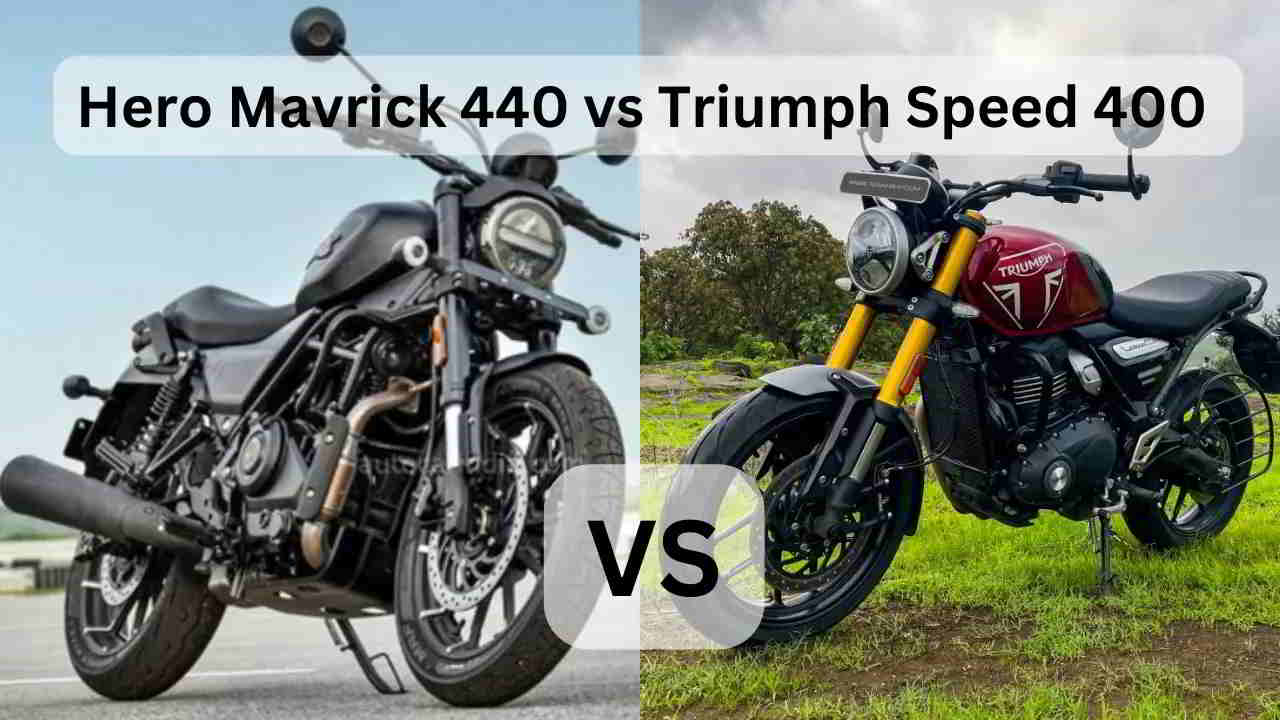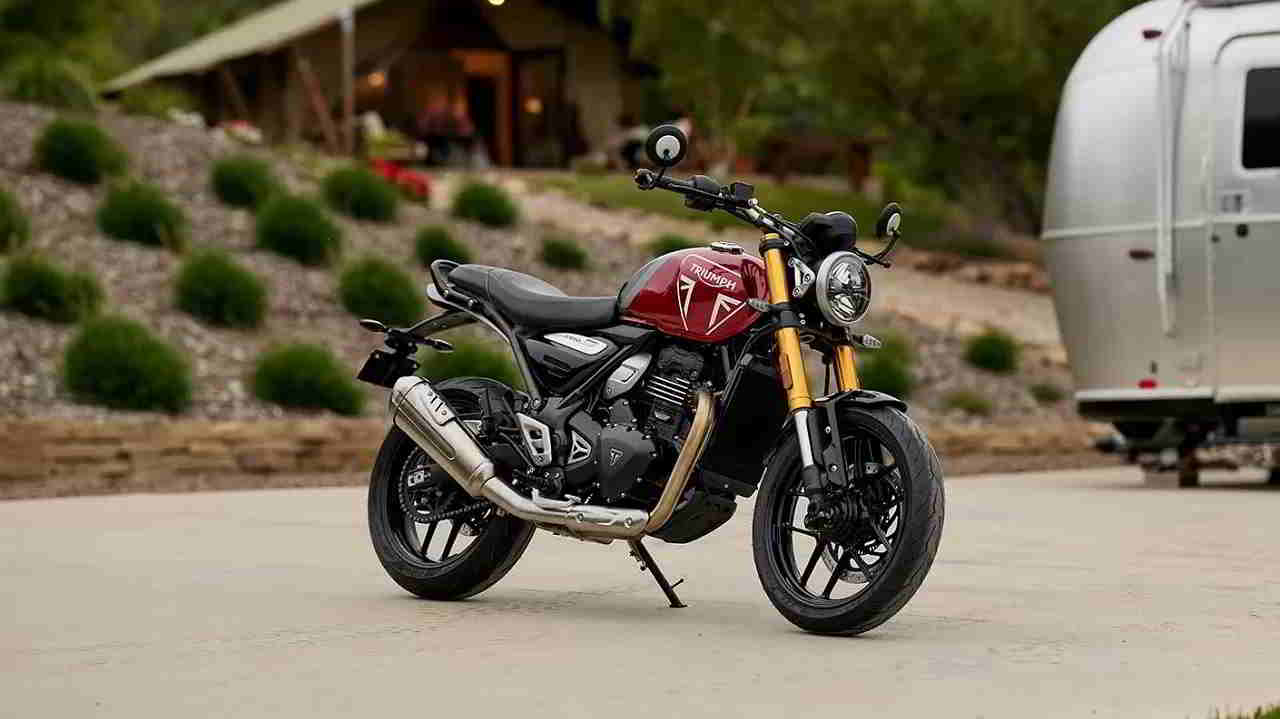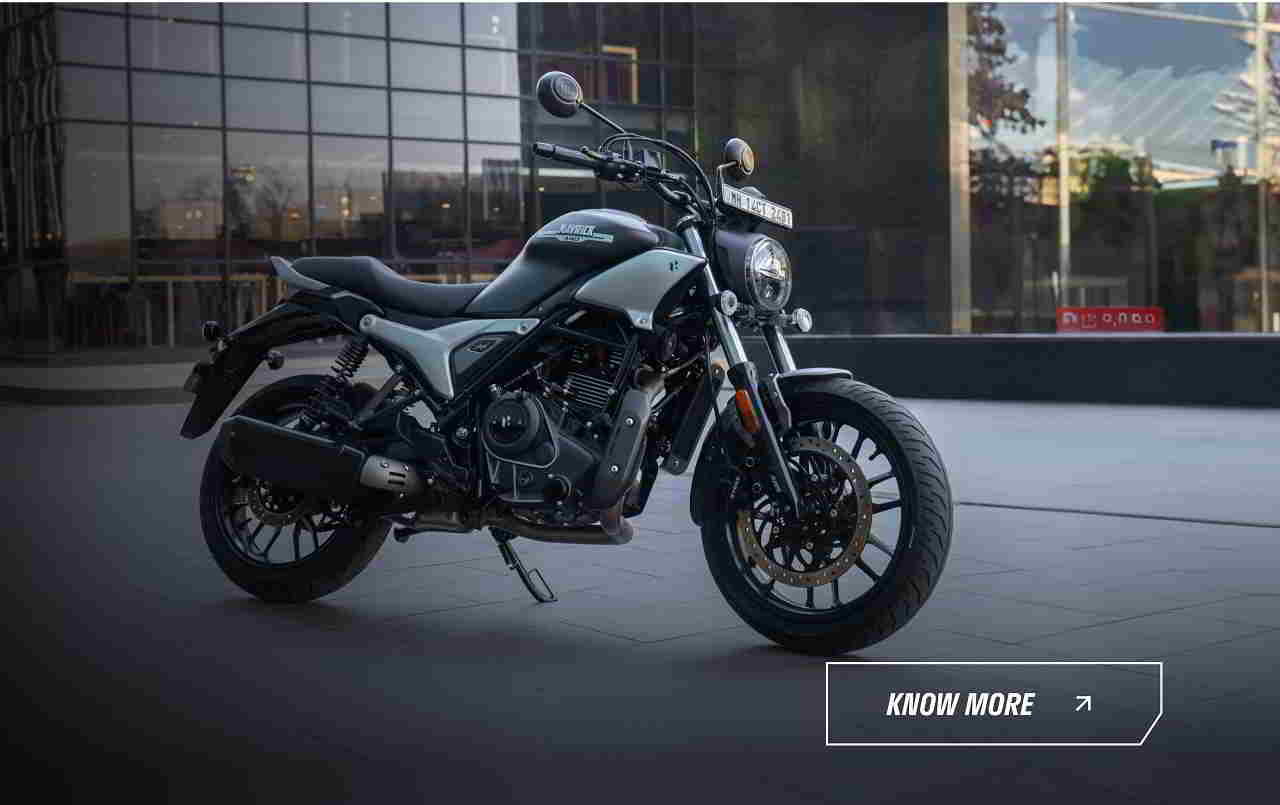Hero Mavrick 440 vs Triumph Speed 400: The Indian motorcycle market has witnessed a thrilling new chapter with the arrival of the Hero Mavrick 440. This homegrown contender boldly enters the ring against the established champion, the Triumph Speed 400. Both motorcycles promise a potent blend of performance and style, but which one reigns supreme? Buckle up as we dissect their features, ride experience, and value proposition to crown the ultimate middleweight champion.

Hero Mavrick 440 vs Triumph Speed 400- Engine & Performance:
- Engine: The Mavrick boasts a 440cc, single-cylinder engine with 27 bhp @6000 RPM and
36 Nm @ 4000 RPM of torque. The Speed 400 counters with a 398.15 cc , three-cylinder unit pumping out 40 PS / 39.5 bhp (29.4 kW) @ 8,000 rpm and 37.5 Nm @ 6,500 rpm. While both offer similar power figures, the Speed’s triple engine delivers a smoother, more refined power delivery with better low-end grunt. However, the Mavrick’s single-cylinder character provides a raw, exhilarating ride experience that some may prefer.
- Transmission: Both motorcycles come equipped with a 6-speed gearbox. The Mavrick’s gear ratios feel slightly taller, offering better fuel economy at cruising speeds. The Speed’s gearbox offers a more precise and sporty feel, ideal for spirited riding.
Dimensions of the Hero Mavrick 440 and Triumph Speed 400:
| Dimension | Hero Mavrick 440 | Triumph Speed 400 |
|---|---|---|
| Length | 2100mm | 2065mm |
| Width | 868mm | 740mm |
| Height | 1112mm | 1080mm |
| Wheelbase | 1338mm | 1377mm |
| Ground Clearance | 175mm | 170mm |
| Fuel Tank Capacity | 13 liters | 13 liters |
| Dry Weight | 181 kg | 176 kg |
- The Mavrick 440 boasts a longer length and wheelbase compared to the Speed 400, translating to potentially better stability at high speeds.
- The Speed 400 is narrower and slightly shorter, making it more nimble and easier to maneuver in tight spaces.
- Both bikes have the same ground clearance, offering decent off-road capabilities.
- Their fuel tank capacities are identical, providing similar riding range on a single tank.
- The Mavrick 440 is marginally lighter than the Speed 400, potentially contributing to slightly better acceleration and handling.
While the dimensional differences between these two motorcycles are subtle, they might influence your choice depending on your riding style and preferences. If you prioritize stability and high-speed riding, the Mavrick’s longer wheelbase might be appealing. If agility and city riding are your focus, the Speed’s nimbleness might be a better fit.

Hero Mavrick 440 vs. Triumph Speed 400: Chassis Showdown
Diving deeper into the mechanical heart of these bikes, let’s compare their chassis constructions:
Frame:
- Mavrick 440: Employs a tubular steel double-cradle frame, a common and cost-effective choice offering decent rigidity and handling.
- Speed 400: Boasts a tubular steel perimeter frame, considered a more performance-oriented design that provides increased torsional rigidity for sharper handling and improved feedback.
Suspension:
- Mavrick 440: Features a telescopic fork setup with preload adjustability at the front and a monoshock absorber with adjustable preload at the rear. This offers basic but adequate ride comfort and handling for everyday riding.
- Speed 400: Ups the ante with inverted telescopic forks at the front and a piggyback reservoir monoshock at the rear, both with fully adjustable compression, rebound, and preload. This allows for fine-tuning the suspension for various riding styles and road conditions, resulting in superior handling and rider confidence.
Brakes:
- Mavrick 440: Comes equipped with single disc brakes on both wheels with single-channel ABS as an optional upgrade. This provides adequate stopping power but may not be as effective as a dual-channel system.
- Speed 400: Sports dual disc brakes on both wheels with standard dual-channel ABS. This offers superior stopping power and confidence in all weather conditions, particularly important for a performance-oriented machine.
- Handling: The Mavrick’s telescopic forks and monoshock suspension offer a comfortable ride, well-suited for city commutes and touring. The Speed’s upside-down forks and piggyback reservoir shock provide sharper handling and confidence at higher speeds, making it a more track-focused machine.
Observations:
- The Speed 400’s chassis construction and suspension are inherently more sophisticated and performance-oriented compared to the Mavrick 440. This translates to sharper handling, better feedback, and improved confidence at higher speeds.
- However, the Mavrick 440’s simpler setup is lighter and more cost-effective, offering decent comfort and handling for everyday riding.
Choosing between these chassis and configurations depends on your priorities. If you prioritize raw performance and precision handling, the Triumph Speed 400’s superior chassis and suspension win hands down. However, if affordability and basic practicality are your primary concerns, the Hero Mavrick 440’s simpler setup provides adequate capabilities without breaking the bank.
Remember, chassis construction is just one piece of the puzzle. Combining this information with the engine, features, and price will help you make the best decision for your needs and budget.

Hero Mavrick 440 vs. Triumph Speed 400: Service Interval Showdown
Keeping your motorcycle in prime condition through regular servicing is crucial for optimal performance, longevity, and safety. Let’s compare the recommended service intervals for the Hero Mavrick 440 and Triumph Speed 400:
Hero Mavrick 440:
- Initial Service: 500 km
- Regular Service: Every 5000 km or 6 months, whichever comes first
Triumph Speed 400:
- Initial Service: 1000 km
- Regular Service: Every 16,000 km or 12 months, whichever comes first
Observations:
- The Mavrick 440 requires more frequent servicing, with initial service recommended at 500 km and subsequent services every 5000 km or 6 months. This might translate to higher maintenance costs over time.
- The Speed 400 has a longer service interval, with initial service at 1000 km and subsequent services every 10,000 km or 12 months. This potentially translates to lower maintenance costs in the long run.
Considerations:
- Riding frequency: If you ride often, shorter service intervals like the Mavrick’s might be beneficial for ensuring optimal performance and preventing issues.
- Warranty terms: Check your specific motorcycle’s warranty terms, as following the recommended service intervals is often crucial for maintaining warranty coverage.
- Cost of service: While the Speed 400 has longer service intervals, the cost per service might be higher due to its more complex technology and higher labor costs.
Choosing the service interval that best suits your needs depends on various factors like riding frequency, budget, and warranty considerations. Both the Mavrick 440 and Triumph Speed 400 offer different service frequencies, so be sure to weigh the pros and cons of each to make an informed decision.
It’s always recommended to consult your motorcycle’s owner’s manual for specific service information and follow the manufacturer’s guidelines for optimal performance and maintenance.
Harley Davidson X440 based Hero Mavrick 440 Unveiled in India: A New Era for Hero MotoCorp
Features & Design:
- Features: The Speed comes loaded with features like ride-by-wire throttle, switchable traction control, and an information-rich instrument cluster. The Mavrick keeps things simple with a basic instrument cluster and halogen headlight. However, it does offer dual-channel ABS as an optional upgrade.
- Design: The Mavrick’s neo-retro design with a round headlight and tear-drop fuel tank is reminiscent of classic café racers. The Speed’s modern, muscular design with exposed engine parts and sharp lines exudes a more aggressive stance.
Price & Value:
- Price: The Mavrick’s biggest trump card is its price tag. Expected Price at around INR 2 lakhs, Exact prices to be revealed later. It significantly undercuts the Speed’s price of nearly INR 2.33 lakhs. This makes the Mavrick a compelling option for budget-conscious riders.
- Value: The Speed, with its superior engine refinement, features, and handling, offers better value for performance-oriented riders willing to pay a premium. However, for those seeking a more affordable and unique cafe racer experience, the Mavrick offers undeniable appeal.
Final Verdict:
The Hero Mavrick 440 and Triumph Speed 400 cater to distinct rider preferences. The Mavrick is a charming cafe racer that delivers a raw, engaging ride at an unbeatable price. It’s perfect for budget-conscious riders who prioritize style and affordability. The Speed 400, on the other hand, is a refined, powerful machine with superior performance and features, ideal for riders who crave a more exhilarating and track-focused experience.
Ultimately, the champion depends on your individual needs and priorities. If you’re looking for a head-turning, affordable cafe racer experience, the Mavrick takes the crown. However, if superior performance, features, and a premium ride are your priorities, the Speed 400 remains the undisputed king of the middleweight class.